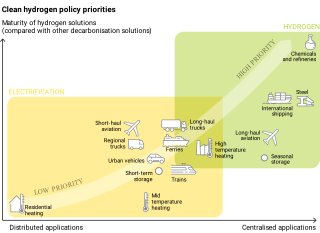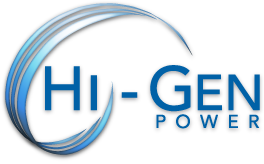Related Research Articles

A fuel cell is an electrochemical cell that converts the chemical energy of a fuel and an oxidizing agent into electricity through a pair of redox reactions. Fuel cells are different from most batteries in requiring a continuous source of fuel and oxygen to sustain the chemical reaction, whereas in a battery the chemical energy usually comes from substances that are already present in the battery. Fuel cells can produce electricity continuously for as long as fuel and oxygen are supplied.

A hydrogen vehicle is a vehicle that uses hydrogen to move it. Hydrogen vehicles include some road vehicles, rail vehicles, space rockets, forklifts, ships and aircraft. Motive power is generated by converting the chemical energy of hydrogen to mechanical energy, either by reacting hydrogen with oxygen in a fuel cell to power electric motors or, less commonly, by hydrogen internal combustion.

The M4, originally the London-South Wales Motorway, is a motorway in the United Kingdom running from west London to southwest Wales. The English section to the Severn Bridge was constructed between 1961 and 1971; the Welsh element was largely complete by 1980, though a non-motorway section around Briton Ferry bridge remained until 1993. On the opening of the Second Severn Crossing in 1996, the M4 was rerouted over it.

Whyalla is a city in South Australia. It was founded as "Hummocks Hill", and was known by that name until 1916. It is the fourth most populous city in the Australian state of South Australia after Adelaide, Mount Gambier and Gawler and along with Port Pirie and Port Augusta is one of the three towns to make up the Iron Triangle. As of June 2018, Whyalla had an urban population of 21,742, having declined at an average annual rate of -0.75% year-over-year over the preceding five years. It is a seaport located on the east coast of the Eyre Peninsula and is known as the "Steel City" due to its integrated steelworks and shipbuilding heritage. The port of Whyalla has been exporting iron ore since 1903.

The hydrogen economy is an umbrella term that draws together the roles hydrogen can play alongside low-carbon electricity to decarbonize those sectors and activities which may be technically difficult to decarbonize through other means, or where cheaper and more energy-efficient clean solutions are not available. In this context, hydrogen economy encompasses hydrogen's production through to end-uses in ways that substantively contribute to phasing-out fossil fuels and limiting climate change.

A fuel cell vehicle (FCV) or fuel cell electric vehicle (FCEV) is an electric vehicle that uses a fuel cell, sometimes in combination with a small battery or supercapacitor, to power its onboard electric motor. Fuel cells in vehicles generate electricity generally using oxygen from the air and compressed hydrogen. Most fuel cell vehicles are classified as zero-emissions vehicles that emit only water and heat. As compared with internal combustion vehicles, hydrogen vehicles centralize pollutants at the site of the hydrogen production, where hydrogen is typically derived from reformed natural gas. Transporting and storing hydrogen may also create pollutants. Fuel cells have been used in various kinds of vehicles including forklifts, especially in indoor applications where their clean emissions are important to air quality, and in space applications. Fuel cells are being developed and tested in trucks, buses, boats, ships, motorcycles and bicycles, among other kinds of vehicles.

Bekal is a small town in the Kasaragod district on the West coast of the state of Kerala, India.
Hydrogen technologies are technologies that relate to the production and use of hydrogen as a part hydrogen economy. Hydrogen technologies are applicable for many uses.
The HyNor-project was a nationally supported project which purpose was to facilitate and coordinate the introduction of hydrogen as a fuel in Norway, running from 2003 to 2012. Toward the commercial introduction of hydrogen vehicles in 2015, the HyNor-project focused on acquiring an early pre-commercial fleet of hydrogen vehicles, and keeping a close dialogue with the leading car manufacturers and other similar initiatives in the Nordic countries and around the world.
The California Hydrogen Highway is a series of hydrogen refueling stations in California. These stations are used to refuel hydrogen vehicles. As of August 2020, there were 42 publicly accessible hydrogen refueling stations in California.

A hydrogen infrastructure is the infrastructure of hydrogen pipeline transport, points of hydrogen production and hydrogen stations for distribution as well as the sale of hydrogen fuel, and thus a crucial prerequisite before a successful commercialization of automotive fuel cell technology.
The BC Hydrogen Highway was a planned hydrogen highway that was supposed to link Vancouver and Whistler with seven hydrogen fueling stations. On March 13, 2007, Canadian Prime Minister Stephen Harper announced funding of almost $200 million Canadian for environmental projects in B.C. including the hydrogen highway. Five stations were built, one each in Whistler, at the University of British Columbia, in Burnaby, and two that were later moved to Surrey. But aside from Whistler they are little-used. Reportedly, only three leased Ford fuel cell cars remain in Surrey. There was a fleet of 20 New Flyer Industries H40LFR conventional buses. However, these buses were pulled out of service in 2014-2015, and were rumoured to be converted to diesel-electric hybrids. However, this has not happened, and as of 2022, the deposition of these buses are unknown. There are no official plans to build any more fuelling stations as the Hydrogen Highway project closed in 2011.
Japan's hydrogen highway is a network of hydrogen filling stations placed along roadsides that provide fuel for hydrogen fuel cell vehicles (HFCV). An HFCV is a vehicle that uses a fuel cell to convert hydrogen energy into electrical energy. The hydrogen that is used in fuel cell vehicles can be made using fossil or renewable resources. The hydrogen highway is necessary for HFCVs to be used. HFCV reduce tailpipe emissions of greenhouse gases. By May 2016, there were approximately 80 hydrogen fueling stations in Japan.

HCNG or H2CNG is a mixture of compressed natural gas and 4–9 percent hydrogen by energy. It may be used as a fuel gas for internal combustion engines and home appliances.
Heavy Water Board (HWB) is a constituent unit under the Department of Atomic Energy in the Government of India. The organisation is primarily responsible for production of heavy water (D2O) which is used as a moderator and coolant in nuclear power as well as research reactors. Other than heavy water, the HWB is also engaged with production of nuclear grade solvents and extraction of rare materials. India is one of the largest manufacturers of heavy water in the world. Similarly, India has one of the world's largest fleets of pressurized heavy water reactors producing most of India's nuclear power supply.

Hi-Gen Power was a London-based developer of projects combining underground coal gasification with carbon capture and storage and alkaline fuel cells. It was established in 2009 to commercialize alkaline fuel cells developed by the fuel cell manufacturer AFC Energy. It is affiliated with B9 Gas.

The Autostrada A22 is one of the most important motorways in Italy, as it connects Pianura padana, the city of Modena and the A1 motorway to Austria through the Brenner Pass, located in the municipality of Brenner.

The Toyota Mirai is a mid-size hydrogen fuel cell vehicle (FCV) manufactured by Toyota, and is the first FCV to be mass-produced and sold commercially. The Mirai was unveiled at the November 2014 Los Angeles Auto Show. As of November 2022, global sales totaled 21,475 units; the top-selling markets were the U.S. with 11,368 units, Japan with 7,435 and the rest of the world with 2,622.

Ra'anana South railway station is an Israel Railways passenger station at the boundary between Ra'anana, Kfar Saba and Kfar Malal. It serves the residents of the southern Sharon region. The station is located on the Sharon Railway, in the center of the large interchange connecting highways 4 and 531.

La Verne station is an under construction light rail station in the Los Angeles Metro Rail system. It is currently under construction as part of the Foothill Extension Project and is slated to open in early 2025.
References
- ↑ HyER Archived 2013-04-12 at archive.today
- ↑ "Vatgas". Archived from the original on 2012-08-18. Retrieved 2012-07-14.